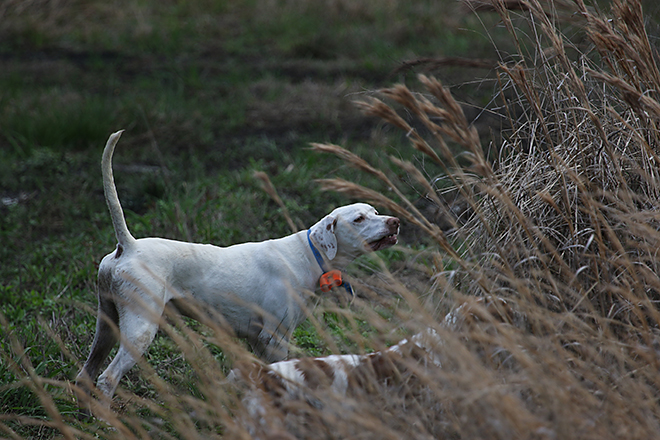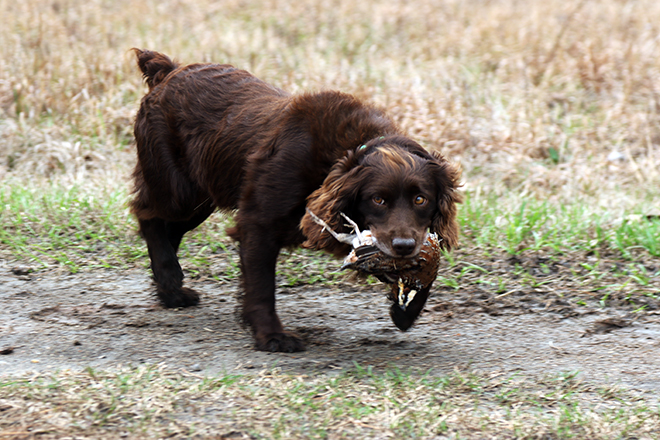By Tom Keer Photos by Chad Love
I cut loose my brace of male setters on a 40-degree Oklahoma morning. Scenting conditions in the light variable wind were perfect, and boy were they were running well! They scoured the land like a Zamboni clears the ice. The point and honor came in the back corner of the field where the grasses drifted to pearl millet and then to tall stands of bi-color, Big and Little Bluestem and oak flats. I paused to soak it all in and then walked forward for a flush.
Some birds exploded, others ran and then flushed, and I got my shotgun swinging. The only problem was that I was horse-collared in the mess and didn't get off a shot. Pointing dog or flushing dog for quail? Today was the day when I wanted both.
The use of both pointing and flushing dogs for has increased over the past few decades. The legendary trainer, handler, and breeder John Rex Gates has tracked some of the recent history. "When I was a kid there were always plenty of wild coveys of bobs, and they didn't need any help from a flushing dog to get off the ground,” says Gates. “But a few decades ago, released-bird operations became popular, and those quail needed a little motivation. Pointers, shaved setters, and other dogs found the coveys and Labs, springers, and other flushing dogs put them in the air. It was a safer way to manage a hunt, particularly since no dogs were injured as a result of shots fired on low-flying birds.”
Ronnie Smith of Ronnie Smith Kennels has been running pointer/flusher combinations on wild birds for decades.
"Running the pointer/flusher combination represents a high point in a trainer/handler's bird hunting year," he says. "If you love dogs as I do then you'll have fun working with various breeds from both kinds of dogs. Using pointers and flushers together is a very effective method for shooters because they get the best bird presentations. Handlers like that fewer dead birds or cripples are lost, too.”
Smith has found that it's important to match your dogs to your hunts, and to pair the way in which you hunt and the type of terrain. “In South Texas, we hunt wild bobwhite quail from buggies,” says Smith. “The early season is really hot, and the soft grasses are in a flat to rolling terrain. In those situations I'll put down big running pointers. Later in the season I relocate to North Texas, Oklahoma and Kansas. Because of the thicker fields and rolling terrain I hunt from foot. As a result I switch to closer working dogs. In those situations I put down shorter-running pointers, setters, Vizlas, shorthairs or one of our 22 generations of Brittanys.”
Smith also matches his flushers to the places he hunts. “Labs do great in super thick and tall grasses because they have the size and power to get through. But if there are regular openings that are low to the ground, then a smaller, athletic dog like a field cocker is a great choice,” says Smith. “Once you select the dogs you're going to run you've got to handle them properly. They always need to work together. I always make my flushing dogs honor the pointing dogs, and I do that by making the flushers sit and wait before I release them. If I'm walking then they must heel and then when we find birds I make them sit and wait for the release.
Both pointers and flushers hunt hard if they get the respect they've earned. If you love bird dogs as I do then give it a try. There always is a lot going on, and when it comes together it's absolutely wonderful."

Jeremy Criscoe, the head trainer at Florida's Blue Cypress Kennels, uses the pointer/flusher combination on wild quail in Florida, Georgia and in Texas. His grandfather bred, trained, and campaigned shorthairs, so Criscoe remains a big fan of that breed. However, these days finds Criscoe running a lot of pointers due to the large tracts of land and extreme heat.
“After the covey is pointed I use British Labrador retrievers as strike dogs,” says Criscoe. I like the labs because they have natural game-finding abilities and can handle any kind of training pressure. They have great noses and bird smarts, and they carry their heads lower which increases their scenting abilities. I've been impressed how our dogs tighten down coveys by circling. They concentrate running birds before the flush which gives all of our hunter's great covey rises. Labs are bulls in thick cover and if you like to hunt waterfowl then you've got a great retriever, too."
Karl Gunzer, director of the sporting dog group at Nestle Purina PetCare, believes hunting with both pointing and flushing dogs might be the epitome of the upland hunting experience.
"Allowing a dog to focus on what it was genetically bred to do brings out the best in us all," says Gunzer. "It's like in football; a wide receiver can block, but probably not as well as a lineman, right? By running both pointers and flushers you're asking each dog to focus on what they were specifically bred to do. Pointers find and point birds while flushers put coveys in the air and retrieve harvested birds to hand. Using each dog in the manner in which it was bred creates an unparalleled hunt. Along the way handlers will learn a lot about dogs. What could be better than that?"

The ultimate might be having a kennel full of just about every sporting breed in the world. I don't know of anyone so fortunate, but in the meantime think about including a pointing and flushing dog on your next quail hunt. Maybe then you won't get all knotted and tangled up like me.
This story originally appeared in the Summer 2019 issue of Quail Forever Journal
. If you liked it and want to be the first to receive more great content like this, become a member today!